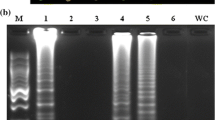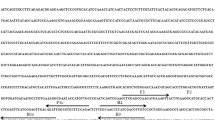Abstract
Puccinia kuehnii is a fungal pathogen that causes orange rust in sugarcane, which is now prevalent in many countries. At the early stage of disease, it is almost indistinguishable from brown rust, which is caused by Puccinia melanocephala. Although several PCR assays are available to detect these diseases, the loop-mediated isothermal amplification (LAMP)-based assay has been reported to be more economical and easier to perform. Under isothermal conditions, DNA is amplified with high specificity and rapidity. Moreover, visual judgment of color change without further post-amplification processing makes the method convenient. The present study was undertaken to detect P. kuehnii genomic DNA using four primers corresponding to a unique DNA sequence of P. kuehnii. The LAMP assay was found to be optimal when 8 mM MgSO4 was used and the reaction was incubated at 63 °C for 90 min. Positive samples showed a color change from orange to green upon SYBR Green I dye addition. Specificity of the LAMP test was checked with DNA of P. melanocephala, which showed no reaction. Sensitivity of the LAMP method was observed to be the same as real-time PCR at 0.1 ng, thus providing a rapid and more affordable option for early disease detection.





Similar content being viewed by others
References
Ryan, C. C., & Egan, B. T. (1989). Rust, Chap. XIII. In C. Ricand, B. T. Egan, A. G. Gillaspie Jr, & C. G. Hughes (Eds.), Diseases of sugarcane, major diseases (pp. 189–210). Amsterdam: Elsevier.
Comstock, J. C., Sood, S. G., Glynn, N. C., Shine, J. M., McKemy, J. M., & Castlebury, L. A. (2008). First report of Puccinia kuehnii, causal agent of orange rust of sugarcane, in the United States and Western Hemisphere. Plant Disease, 92, 175.
Grisham, M. P., Hoy, J. W., Haudenshield, J. S., & Hartman, G. L. (2012). First report of orange rust caused by Puccinia kuehnii in sugarcane in Louisiana. Plant Disease, 97, 426.
Ovalle, W., Comstock, J. C., Glynn, N. C., & Castlebury, L. A. (2008). First report of Puccinia kuehnii, causal agent of orange rust of sugarcane, in Guatemala. Plant Disease, 92, 973.
Chavarria, E., Subirós, F., Vega, J., Ralda, G., Glynn, N. C., Comstock, J. C., & Castlebury, L. A. (2009). First report of orange rust of sugarcane caused by Puccinia kuehnii, causal agent of orange in Costa Rica and Nicaragua. Plant Disease, 93, 425.
Flores, R. C., Loyo, J. R., Ojeda, R. A., Rangel, O. C. A., Cerón, F. A., Márquez, W., et al. (2009). First report of orange rust of sugarcane caused by Puccinia kuehnii in Mexico, El Salvador, and Panama. Plant Disease, 93, 1347.
Barbasso, D., Jordão, H., Boldini, J., & Bressiani, J. (2010). First report of Puccinia kuehnii, causal agent of orange rust of sugarcane, in Brazil. Plant Disease, 94, 1170.
Pérez-Vicentea, L., Martín-Trianab, E. L., Barrosoc, F., Martínez-de la Partea, E., Borrás-Hidalgod, O., & Hernández Estévezd, I. (2010). Definitive identification of orange rust of sugarcane caused by Puccinia kuehnii in Cuba. Plant Pathology, 59, 804.
Cadavid, M., Ángel, J. C., & Victoria, J. I. (2012). First report of orange rust of sugarcane caused by Puccinia kuehnii in Colombia. Plant Disease, 96, 143.
Briggs, G. C., Nakhid, Z., Allene, A. T., Ayats, J., Despradel, J. O., & Elibox, W. (2014). First report of orange rust disease of sugarcane in the Dominican Republic. Plant Disease, 98, 1010.
Garcés, F. F., Fiallos, F. F., Silva, E., Martinez, F., Aime, M. C., Comstock, J. C., et al. (2014). First report of orange rust of sugarcane caused by Puccinia kuehnii in Ecuador. Plant Disease, 98, 842.
Magarey, R. C., Willcox, T. G., Croft, B. J., & Cordingley, A. (2001). Orange rust, a major pathogen affecting crops of Q124 in Queensland in 2000. Proceedings of the Australian Society of Sugar Cane Technologists, 23, 274–280.
Glynn, N. C., Dixon, L. J., Castlebury, L. A., Szabo, L. J., & Comstock, J. C. (2010). PCR assays for the sugarcane rust pathogens Puccinia kuehnii and P. melanocephala and detection of SNP associated with geographical distribution in P. kuehnii. Plant Pathology, 59, 703–711.
Liu, J., Xu, L., Guo, J., Chen, R., Grisham, M. P., & Que, Y. (2013). Development of loop-mediated isothermal amplification for detection of Leifsonia xyli subsp. xyli in sugarcane. BioMed Research International, 2013, 1–8.
Chandra, A., Keizerweerd, A. T., Que, Y., & Grisham, M. P. (2015). Loop-mediated isothermal amplification (LAMP) based detection of Colletotrichum falcatum causing red rot in sugarcane. Molecular Biology Reports, 42, 1309–1316.
Keizerweerd, A. T., Chandra, A., & Grisham, M. P. (2015). Development of a reverse transcription loop-mediated isothermal amplification (RT-LAMP) assay for the detection of Sugarcane mosaic virus and Sorghum mosaic virus in sugarcane. Journal of Virological Methods, 212, 23–29.
Notomi, T., Okayama, H., Masubuchi, H., Yonekawa, T., Watanabe, K., Amino, N., & Hase, T. (2000). Loop-mediated isothermal amplification of DNA. Nucleic Acids Research, 28, e63.
Nie, X. Z. (2005). Reverse transcription loop-mediated isothermal amplification of DNA for detection of Potato virus Y. Plant Disease, 89, 605–610.
Grisham, M. P., & Pan, Y. B. (2007). A genetic shift in the virus strains that cause mosaic in Louisiana sugarcane. Plant Disease, 91, 453–458.
Wang, Y., Lan, Q. K., Zhao, X., Zhu, Z., & Cheng, Y. (2009). Development and application of loop-mediated isothermal amplification for detection of genetically modified crops. Journal of Integrative Agriculture, 42, 1473–1477.
Guan, X. Y., Guo, J. C., Shen, P., Yang, L. T., & Zhang, D. B. (2010). Visual and rapid detection of two genetically modified soybean events using loop-mediated isothermal amplification method. Food Analytical Methods, 3, 313–320.
Soliman, H., & El-Matbouli, M. (2006). Reverse transcription loop-mediated isothermal amplification (RT-LAMP) for rapid detection of viral hemorrhagic septicaemia virus (VHS). Veterinary Microbiology, 114, 205–213.
Markoulatos, P., Siafakas, N., & Moncany, M. (2002). Multiplex polymerase chain reaction: a practical approach. Journal of Clinical Laboratory Analysis, 16, 47–51.
Fukuta, S., Ohishi, K., Yoshida, K., Mizukami, Y., Ishida, A., & Kanbe, M. (2004). Development of immune capture reverse transcription loop-mediated isothermal amplification for the detection of tomato spotted wilt virus from chrysanthemum. Journal of Virological Methods, 121, 49–55.
Nemoto, J., Sugawara, C., Akahane, K., Hashimoto, K., Kojima, T., Ikedo, M., et al. (2009). Rapid and specific detection of the thermostable direct hemolysin gene in Vibrio parahaemolyticus by loop-mediated isothermal amplification. Journal of Food Protection, 72, 748–754.
Fu, S. J., Qu, G. G., Guo, S. J., Ma, L., Zhang, N., Zhang, S. L., et al. (2011). Applications of loop-mediated isothermal DNA amplification. Applied Biochemistry and Biotechnology, 163, 845–850.
Acknowledgments
Amaresh Chandra is grateful to the Department of Biotechnology, Government of India, New Delhi, India for awarding the DBT-CREST Fellowship (BT/IN/DBT-CREST Awards/05/AC/2012-12). Amber Keizerweerd and Michael Grisham are thankful for financial support provided by the United States Department of Agriculture, Agriculture Research Service (CRIS Project: 6410-22000-013-00D). Thanks are also due to Kathryn Warnke for her technical support in conducting the real-time PCR assay. We also thank Dr. Duncan Clark of OptiGene Limited for his assistance in primer design.
Disclaimer
Product names and trademarks are mentioned to report factually on available data; however, the USDA neither guarantees nor warrants the standard of the product, and the use of the name by USDA does not imply the approval of the product to the exclusion of others that may also be suitable. The experiments reported comply with the current laws of the U.S.A.
Author information
Authors and Affiliations
Corresponding author
Ethics declarations
Conflict of Interest
The authors declare that they have no conflict of interest.
Rights and permissions
About this article
Cite this article
Chandra, A., Keizerweerd, A.T. & Grisham, M.P. Detection of Puccinia kuehnii Causing Sugarcane Orange Rust with a Loop-Mediated Isothermal Amplification-Based Assay. Mol Biotechnol 58, 188–196 (2016). https://doi.org/10.1007/s12033-016-9914-5
Published:
Issue Date:
DOI: https://doi.org/10.1007/s12033-016-9914-5




